BLOG, or DIE. Author Bio
Wednesday, 23 March 2011
Help Wanted
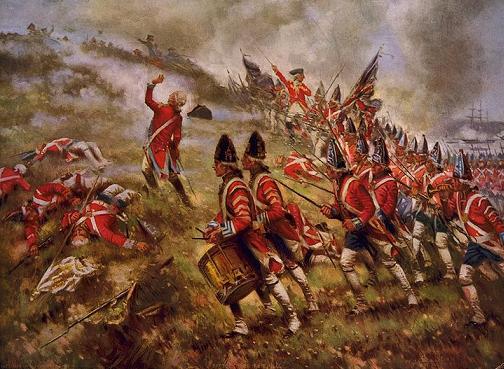
Many of my fellow historians and bloggers boast a long lineage of American ancestors, some going as far back as the Colonial-era. I know of several individuals with over 6-generations of kin, some who lived in the same state. Many of them are descended from veterans who participated in the Revolutionary and/or Civil War. I do not share their ancestry as relatives on both my father and mother’s immediate side did not settle here until the 1900’s. In fact, I am only a 2nd-generation American as my parent’s parents came over on the boat as children. This has prevented me from becoming anything other than an associate-member of heritage groups like the Sons of Confederate Veterans and the Sons of the Revolution.
That said, my grandmother on my mother’s side came to America from England. Her family had lived there for generations so it is quite possible that I have ancestors who participated in the Revolution on the British side. My question is for those of you who know how to research this type of genealogy: How would I even begin to trace someone back to the British ranks? Are there any resources or websites that would provide this kind of information? If I was searching for a soldier in the Civil War I would start by looking for pension papers, but I have no idea where to find data on Redcoats. Does it even exist? I have two last names to go on. Any advice or assistance would be greatly appreciated. Please email me here.

Tuesday, 22 March 2011
The Catholic-Muslim Connection
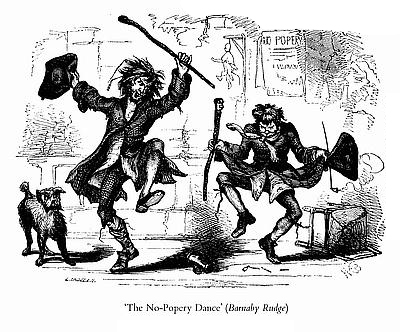
Baylor University scholar Thomas S. Kidd penned a thought-provoking Op-Ed in the March 10 online edition of The Christian Science Monitor titled Muslim Americans: What would Jesus (or George Washington) do?. In it he draws a parallel between the bigotry that was directed towards Catholics in early America and the angst that is directed towards Muslims today. Frankly, I’ve never made that connection until now. Just as Catholics were once feared by the Protestant majority, Muslims have become, in the minds of many Americans, the great spiritual enemy. This wasn’t always so. In fact, there was a time in America when Muslims were probably more likely to be accepted than Catholics.Following the Protestant Reformation of the 1500’s, a strong movement arose against the Catholic Church of England. Many immigrants brought their own anti-Catholicism beliefs with them to the New World where it eventually became a mainstream point of view. Their prejudices were based on political and theological differences. In 1642, the Colony of Virginia went so far as to enact a law prohibiting Catholics from settling there. A similar proclamation was drafted by the Massachusetts Bay Colony. The results were a drastic difference between protestant and Catholic settlers. Even "Catholic-friendly" states had remained unbalanced. In 1634, the state of Maryland recorded less than 3,000 Catholics out of a population of 34,000 (around 9% of the population).
Many of the Founding Fathers who preached of liberty and religious freedom distrusted the denomination. Samuel Adams echoed this sentiment stating, “What we have above everything else to fear is Popery.” Thomas Jefferson condemned the Roman Catholic clerics when he wrote, “History, I believe, furnishes no example of a priest-ridden people maintaining a free civil government,” and, “In every country and in every age, the priest has been hostile to liberty. He is always in alliance with the despot, abetting his abuses in return for protection to his own.” John Adams attended a Catholic mass in Philadelphia in 1774 and later ridiculed the rituals practiced by parishioners.
Looking back to those days of intolerance it may be surprising to find that it was General George Washington, a consummate politician, who rose above public opinion to support his Catholic countrymen. Washington was one of the first leaders to be outspoken on the subject of religious bigotry and he took a great risk by voicing an unpopular sentiment. In retrospect this move may have been far more practical than benevolent as Washington no doubt realized that he needed to win the favor of foreign countries that accepted Catholicism, especially France. He also required the service of Catholic military men both domestic and foreign. This included the Marquis de Lafayette, a Catholic Frenchmen who would play a major role in America’s fight for independence.
For years the country’s Englishmen had celebrated “Guy Fawkes Day” also known as “Pope’s Day” on November 5th. The importance of this date commemorated an incident known as “The Gunpowder Plot” in which a Catholic dissident named Guy Fawkes attempted to blow up Parliament in 1605. As part of the festivities, an effigy was burned, depicting the sitting Pope of the Catholic Church. In November of 1775 Washington issued general orders condemning what he called a “ridiculous and childish custom of burning the effigy of the pope.” He added that “American Catholics are among those we ought to consider as brethren embarked on the same cause, the defense of the general liberty of America.” By taking this stand against religious bigotry, Washington appeared both tolerant and diplomatic. This likely helped him to secure the French allies which he desperately needed to win the war. His entire proclamation read:
As the Commander in Chief has been apprized of a design form'd for the observance of that ridiculous and childish custom of burning the Effigy of the pope--He cannot help expressing his surprise that there should be Officers and Soldiers in this army so void of common sense, as not to see the impropriety of such a step at this Juncture; at a Time when we are solliciting, and have really obtain'd, the friendship and alliance of the people of Canada, whom we ought to consider as Brethren embarked in the same Cause. The defence of the general Liberty of America: At such a juncture, and in such Circumstances, to be insulting their Religion, is so monstrous, as not to be suffered or excused; indeed instead of offering the most remote insult, it is our duty to address public thanks to these our Brethren, as to them we are so much indebted for every late happy Success over the common Enemy in Canada.
Although anti-Catholic sentiment remained in America for some time to come, the official banning of “Pope’s Day” by one of America’s most revered leaders dampened the spirit tremendously. By 1776 the tradition was no longer acknowledged by the masses. This change in public opinion allowed the once ostracized denomination to flourish beside its protestant brethren. Today the Catholic faith makes up almost 24% of the U.S. population with 301 million members.
The nation’s current Muslim citizenship is estimated at approximately 2.6 million, much of which is ostracized like the Catholics of days past. Just as the bloody history of the Crusades blemished the Catholics reputation during colonial times, today’s anti-Muslim sentiments resulted from the terrorist attacks of September 11, 2001. Ironically the resulting military actions in the Middle East sent scores of Muslims fleeing the extreme-fundamentalism of their own faith to seek sanctuary in the United States. This mass influx of refugees mirrored that of the earliest Christians who fled from Europe to the New World in order to escape religious persecution. Today the debate remains over the acceptance of Muslim customs and religious practices. This includes the issue of requiring assimilation for nationalization.
Just as early immigrant Catholics were judged on the sins of the crusaders, Muslims in today’s time are often feared to be jihadists. This underlying suspicion has led to a heightened form of prejudice that is often masked behind the guise of vigilance. Perhaps this is no more illustrated than in the recent proposal to add an anti-Shariah amendment into Texas’s constitution. Proponents of the law believe that it is crucial to maintaining the fundamentals of the country, while those who oppose it believe an official denunciation of the Muslim faith by the government to be contrary to the country’s founding principles of “liberty and justice for all.” When examining this argument strictly from a constitutional point of view, it’s not that hard to see both perspectives. Hence the conundrum. Mainstream American-Muslims would certainly never practice such primitive traditions, but the radical-extremists who have hijacked their faith continue to pose a real threat.
This controversial amendment would not be the first time that a clause was instituted to negate a particular religious group. Prior to Washington’s advocacy several states had devised loyalty oaths designed to exclude Catholics from holding state and local office. Yet at the same time Catholics were serving at the Constitutional Convention. This included Thomas Fitzsimons and Daniel Carroll who were delegates from Pennsylvania and Maryland. Both men’s signatures appear on the U.S. Constitution. Carroll had served in the Continental Congress and had signed the Articles of Confederation as well.
Another close comparison between Catholics of the past and Muslims of the present exists in military manpower. Just as Washington’s ranks of the Continental army included Catholic troops, today’s military boasts between 10,000-20,000 Muslims (according to the Department of Defense). The military’s rising requirement for Muslim chaplains is also a testament to the expanding integration of followers of Islam. Ironically, most of the conflicts that the U.S. military is currently engaged in revolve around religious differences between cultures. Muslims are fighting against Muslims on behalf of the U.S. – just as Catholics fought against members of the Catholic Church of England on behalf of their fellow colonists.
To this day religion still remains the great divider. Regardless of one’s spiritual preference, it does us well to recall the sins of our past in order to deal more justly with the present. Only time will tell if the post-traumatic reaction from 9/11 can be healed in the name of unity. Until then we can all gain a unique perspective of what it feels like to be a Muslim by remembering what it once felt like to be a Catholic.

Monday, 21 March 2011
Blog Browsing
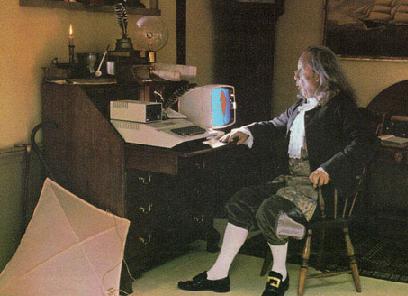
ABOVE: Apple computer advertisement (circa 1980’s)
Today I thought I would introduce you to some of the other blogs that are dealing with the Revolutionary War and Colonial times. A quick Google search identifies a plethora dedicated to this era. Unfortunately, the vast majority of them are either very amateur or woefully out of date. I spent some time this weekend sifting through the Internet to identify the cream of the crop in Revolutionary War blogs. Here are my findings:
Boston 1775: This blog focuses on history, analysis, and unabashed gossip about the start of the American Revolution in Massachusetts. The author is particularly interested in the experiences of children in 1765-75. He has published scholarly papers and acted as a consultant for an episode of PBS’s History Detectives.
American Revolution Blog: This long-running blog covers all aspects of the Revolution from battles to politics. It is maintained by two history buffs, the pastor of Olney Baptist Church in Olney, MD and a former graduate student of history.
American Revolution and Founding Era: This blog explores the founding of the United States of America, including topics such as the causes, weapons, battles, and personalities of the American Revolution as well as the Constitution, the early Presidents, the War of 1812, and the expansion of the United States.
A Miniature History of the American Revolution: This is a blog about the battles of the American Revolution. The tone is scholarly and includes original accounts of military actions that have not been well discussed. Periodic posts discuss the hobby of military miniatures used to illustrate specific battles.
British Soldiers, American Revolution: This blog is quote: “A place for information about British soldiers who served during the American Revolution, 1775-1783. Thousands of soldiers wore red coats, but little is known about them as individuals. This site will change that, soldier by soldier.”
The 2d Virginia Regiment: This is the blog of the 2d Virginia Regiment, a group of dedicated historians with a love of history who represent the life and times of the common Continental soldier. The 2d recreates the entire Revolutionary War scene through encampments and battlefield reenactments.
Walking the Berkshires: This award-winning blog is quote “…an eclectic weaving of human narrative, natural history, and other personal passions with the Berkshire and Litchfield Hills as both its backdrop and point of departure.”

Friday, 18 March 2011
U.S. Marshal Edward Carrington
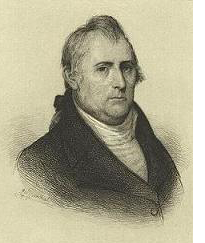 As a technical-writer for the U.S. Marshals Service, I have the privilege of working with some of the most dedicated people in federal law-enforcement. No other division under the Department of Justice can boast the history of the USMS. From its storied establishment in 1789 by George Washington, to its long list of noteworthy marshals including Frederick Douglass and Wyatt Earp, the USMS is the oldest, and in my opinion, the finest agency in the country. As a Virginia resident I am particularly interested in those who wore ‘the Star’ for my home state.
As a technical-writer for the U.S. Marshals Service, I have the privilege of working with some of the most dedicated people in federal law-enforcement. No other division under the Department of Justice can boast the history of the USMS. From its storied establishment in 1789 by George Washington, to its long list of noteworthy marshals including Frederick Douglass and Wyatt Earp, the USMS is the oldest, and in my opinion, the finest agency in the country. As a Virginia resident I am particularly interested in those who wore ‘the Star’ for my home state.
Edward Carrington was the first United States Marshal for the state of Virginia. Born in Cumberland County in 1748, he was a successful attorney who managed a large plantation as well as his family’s estate. He was also active in politics to the point of becoming a close confidant of George Washington’s. Carrington was approached by Washington to advise him on the growth of Thomas Jefferson’s Republican Party in the Old Dominion. He also provided critiques of potential cabinet candidates and offered opinions on what qualifications should be necessary for political appointments.
As a soldier Carrington served in the First Continental Artillery during the Revolutionary War. He rose to the rank of Lieutenant Colonel and was tasked as the quartermaster-general for Nathaniel Green’s Southern Campaign. During his service Carrington commanded artillery units in engagements against the redcoats at Hobkirk’s Hill and Yorktown. His military service off of the battlefield was equally noteworthy. In addition to being appointed to meet with British representatives to discuss an exchange of prisoners, Carrington was tasked with managing the selling of goods and property confiscated by the Continental Army.
After the British surrendered in 1781, Carrington returned home to practice law and manage his family’s properties. In 1785, and again in ’86, he was nominated as a delegate to represent the state of Virginia at the Continental Congress. In the spring of 1789, Carrington volunteered his services to the new government. Later that year, the United States Marshal Service was established by President Washington who formed the first federal law-enforcement agency under the Judiciary Act of September 24, 1789. Section 27 of that act reads:
And be it further enacted, That a marshal shall be appointed in and for each district for a term of four years, but shall be removable from office at pleasure, whose duty it shall be to attend the district and circuit courts when sitting therein, and also the Supreme Court in the district in which that court shall sit.(b) And to execute throughout the district, all lawful precepts directed to him, and issued under the authority of the United States, and he shall have the power to command all necessary assistance in the execution of his duty, and to appoint as shall be occasion, one or more deputies...
In appreciation for his many years of service, Carrington was appointed as the U.S. Marshal for the District of Virginia at the age of 41. He held the position for a little over 2 years (1789-1791) before he was appointed as the state’s Supervisor of Distilled Spirits.
In 1794, Carrington temporarily retired from public service while maintaining his friendship with Washington. When President John Adams was preparing to raise another volunteer army in anticipation of a war with France, Carrington was named as the supreme commander over an aging Washington. A few months later, America resolved the crisis with France and Washington died of pneumonia.
Carrington remained in Virginia and went on to serve two terms as the mayor of Richmond (1807-1810). During the first year of his first term, he served as the foreman on the jury for the Aaron Burr treason trial. After finding Burr ‘not guilty’ Carrington returned to the mayor’s office where he continued to serve until October 28, 1810, when he died at the age of 62.
References:
USMS website: The First Generation of U.S. Marshals
Congressional Biography: Edward Carrington
Constitution.org: Judiciary Act of September 24, 1789
Hopkins, Garland Evans. Colonel Carrington of Cumberland

Tuesday, 15 March 2011
A History-Mystery
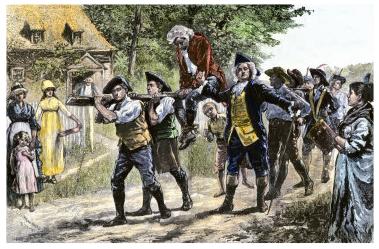 As mentioned below I am researching source-material on the life of a local Loyalist named Adam Allan. While discussing this with Pittsburgh-based historian Tom Byers another Adam Allen was brought to my attention. The Loyalist named “Allan” that I am looking for was born in Great Britain, operated a stocking manufactory, and lived in Williamsburg and Fredericksburg before moving to New Brunswick after being tarred and feathered. Tom’s Loyalist, spelled “Allen,” was born in Scotland, moved to New Brunswick where he enlisted and became a Lieutenant in the Queens Grenadiers in 1779, retaining his commission in 1793 when Britain went to war with France. Both men filed claims for land after the war. So the question remains, is this the same guy?
As mentioned below I am researching source-material on the life of a local Loyalist named Adam Allan. While discussing this with Pittsburgh-based historian Tom Byers another Adam Allen was brought to my attention. The Loyalist named “Allan” that I am looking for was born in Great Britain, operated a stocking manufactory, and lived in Williamsburg and Fredericksburg before moving to New Brunswick after being tarred and feathered. Tom’s Loyalist, spelled “Allen,” was born in Scotland, moved to New Brunswick where he enlisted and became a Lieutenant in the Queens Grenadiers in 1779, retaining his commission in 1793 when Britain went to war with France. Both men filed claims for land after the war. So the question remains, is this the same guy?
It’s quite possible. Tom reminded me that many Loyalists who were tarred and feathered later found their way into a redcoat. He added that the spelling of the name Allan/Allen sometimes gets slipshod in the handwritten record keepings of the 18th c. Another discrepancy he noticed was in their birth-years. One source has ‘Allen’ as being born in 1757, but with handwriting in those days, 1757 could just as easily been 1751 which happens to be when ‘Allan’ was born. What makes this possibility particularly interesting is the notion that Adam Allan/Allen would have certainly had an ax to grind in Virginia. What better way to get revenge than as a soldier in the ranks of the British Army?
So what originally started out as an investigation into the life of a businessman who was subjected to chastisement and forced to flee the town, now has the potential to be the story of a tortured-Tory turned revengeful redcoat. Tom has already directed me to some great sources on Loyalists who enlisted. Stay tuned as the hunt is on to find the REAL Adam Allan/Allen…

Newer | Latest | Older









 As a technical-writer for the U.S. Marshals Service, I have the privilege of working with some of the most dedicated people in federal law-enforcement. No other division under the Department of Justice can boast the history of the USMS. From its storied establishment in 1789 by George Washington, to its long list of noteworthy marshals including Frederick Douglass and Wyatt Earp, the USMS is the oldest, and in my opinion, the finest agency in the country. As a Virginia resident I am particularly interested in those who wore ‘the Star’ for my home state.
As a technical-writer for the U.S. Marshals Service, I have the privilege of working with some of the most dedicated people in federal law-enforcement. No other division under the Department of Justice can boast the history of the USMS. From its storied establishment in 1789 by George Washington, to its long list of noteworthy marshals including Frederick Douglass and Wyatt Earp, the USMS is the oldest, and in my opinion, the finest agency in the country. As a Virginia resident I am particularly interested in those who wore ‘the Star’ for my home state. As mentioned
As mentioned